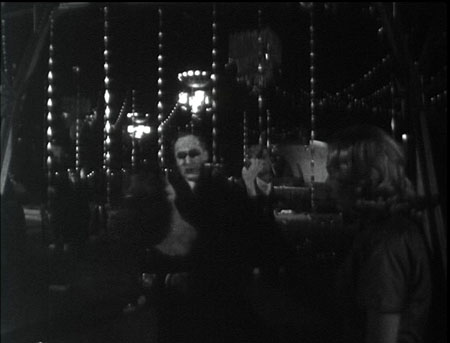
DIRECTED BY: Chris Fuller
FEATURING: Kayla Tabish, Travis Maynard, Chris Fuller (as Lewis Brogan), Jacob Reynolds
PLOT: Bad poetry interrupts episodes in the lives of three teens or twenty-somethings at about the time of the 1997 St. Petersburg, Florida race riots.

WHY IT WON’T MAKE THE LIST: It’s only fitfully weird, but consistently dull and pretentious. Life on this planet is full of hardships and disappointments; no one should voluntarily compound their woes by watching Loren Cass.
COMMENTS: A voice says “after the 1997…” A solo trumpet launches a doomed search for a melody. A boy wakes up on the floor of a mechanic’s garage. Another boy, with a shaved head, piercings and tattoos, presumably a skinhead, wakes up on a couch and goes outside to lie in the middle of the street. A cute blonde girl wakes up next to a black male. The boy from the garage picks up the skinhead. The girl takes her own car. The three drive to school. The parking lot is full but the hallways inside are empty. We get a nice look at the urinals. Someone loads a gun. We see the urinals from a different angle. An older man takes a shot of whiskey. The two boys are next to last to leave the parking lot. At a stoplight a black guy jumps out of a van and punches the punk kid with through an open window. They have a fight. The screen goes blank and a street poet tells us St. Petersburg is “a dirty dirty town by a dirty dirty sea.” What’s going on here? The cute blonde works at a diner where no one ever orders anything. She has car trouble and takes it to the young mechanic. He fixes it and they go to dinner together. She shovels gray cubes of meat into her mouth. He doesn’t eat. They barely talk but look at each other a lot. They are in love. What’s going on here? Other things happen. They aren’t interesting, either. Some kids drink beer and say the F-word a lot until the Man comes and hassles them. The skinhead’s hobby is to ride the bus at night. We look at his face. He looks alienated. Snippets of bad beatnik poetry and drunken ramblings play on the soundtrack. There is a punk concert. The skinhead falls asleep on the bus and dreams he’s a victim of spontaneous human combustion. Years ago an embattled politician committed suicide at a press conference. The footage is in the public domain so anyone can insert it into their movie at random. The mechanic and the cute girl have sex. The skinhead scratches “Loren Cass” onto his arm with a hypodermic needle he finds in a dumpster. He swallows a handful of pills in a desperate attempt to get out of the movie. He vomits them up. The movie won’t let him out that easily. He wakes up the next morning and looks into the camera. He looks disaffected. The trumpet player still hasn’t found a melody. The credits roll. What just went on here? The Variety critic stayed awake and alert long enough to write that he had just seen “a starkly radical film debut of uncommon power and artistic principle.” Seriously, what is going on here?
The events are set around the times of the St. Petersburg race riots, which we know because we see newsreel footage of the aftermath and hear audio clips of a rabble-rousing black preacher. The movie supplies no context to suggest whether these incidents take place before, after, or during the riots. But the subtext makes the film political and important. Use of the tragically real footage of Pennsylvania Treasurer Budd Dwyer blowing his brains out on camera either says something insightful about fiscal corruption in the Keystone state in the 1980s, or is completely indefensible.
WHAT THE CRITICS SAY:






